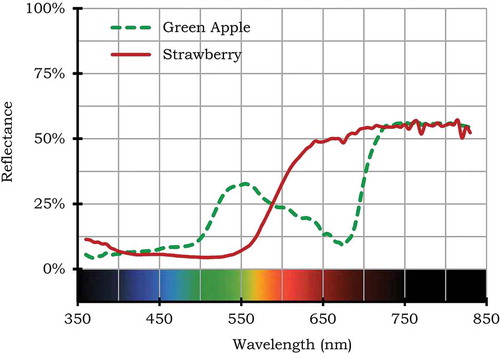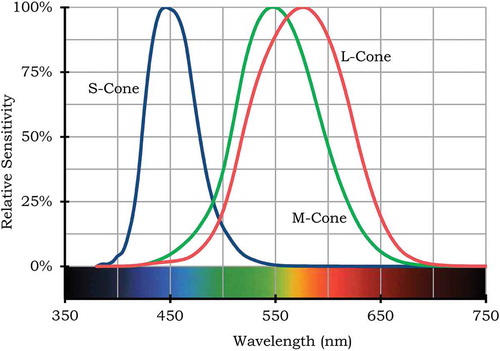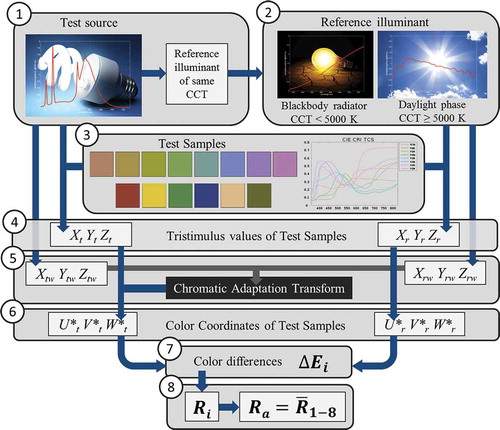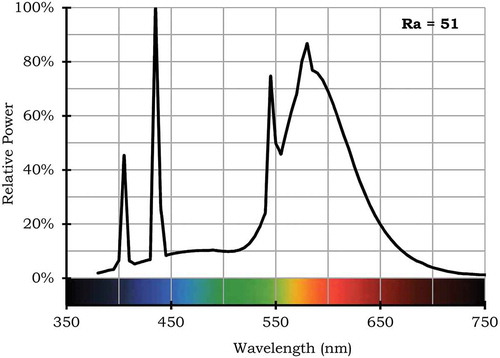Figures & data
Fig. 2 Spectral power distributions (SPDs) for some of the phases of the reference illuminants used in the computation of CRI. All SPDs are in relative units, normalized to have a value of 1.0 at 560 nm.
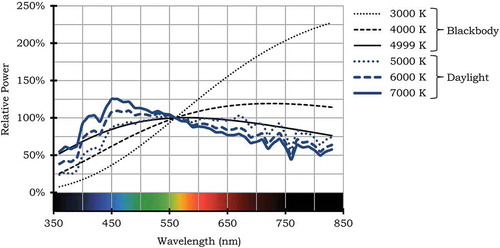
Fig. 5 The 1931 CIE 2° standard observer, including the , and
color matching functions (CMFs), sometimes also called the XYZ CMFs. For historical background, see MacAdam [Citation1970].
![Fig. 5 The 1931 CIE 2° standard observer, including the , and color matching functions (CMFs), sometimes also called the XYZ CMFs. For historical background, see MacAdam [Citation1970].](/cms/asset/4e86d8ed-e5be-4ae1-8dc6-deeb5454edf6/ulks_a_989802_f0005_oc.jpg)
Fig. 6 CIE 1931 chromaticity diagram illustrating the location of the spectrum locus, purple boundary, blackbody locus, and several lines of constant CCT. Note that the background colors are more symbolic than literal because color appearance depends on several additional factors that are not included in this chart, such as luminance, background, and context.
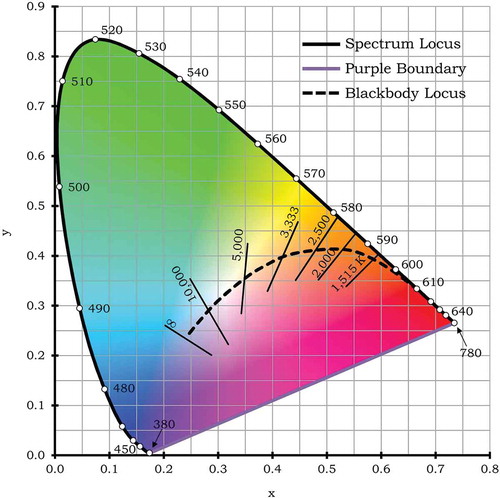
Fig. 7 Three SPDs that have the same chromaticity, which means that they are metameric. Because chromaticity is identical (0.4369, 0.4041), the CCT is also identical (3000 K in this example), yet these sources will render objects very differently. The CRI values are 34 for the three-LED mixture, 94 for the four-LED mixture, and 100 for the blackbody radiator.
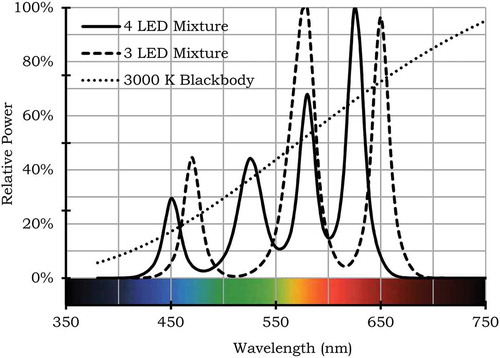
Fig. 8 Influence of adaptation on color appearance. Left: Two scenes, one at noon (top) and the other at sunset (bottom), as they would appear without chromatic adaptation. Right: The same two scenes as viewed with chromatic adaptation. Note that chromatic adaptation corrects, to a degree, for the slight bluish and yellowish color cast present in the top and bottom left images, respectively.

Fig. 9 Cases “A” (left) and “B” (right), as described in the text, illustrating the same room illuminated with two different light sources that provide the same illuminance and have the same chromaticity but different spectral power distributions.

Fig. 10 Spatial illumination pattern (right) and its graphical depiction (left) showing illuminance (E) vs. position measured along the dotted line (x).

Fig. 11 Spatial reflectance pattern (right) and its graphical depiction (left) showing reflectance (R) vs. position measured along the dotted line (x).

Fig. 12 Overlapping the illumination pattern of Fig. 10 onto the reflectance pattern of Fig. 11 and plotting the intensity pattern of the reflected light, which is the mathematical product of illuminance, E, and reflectance, R, thus denoted as ER. In this example, because of the relative spacing, there is no position that simultaneously has non-zero illumination and non-zero reflectance, so in this case no light reflects anywhere.
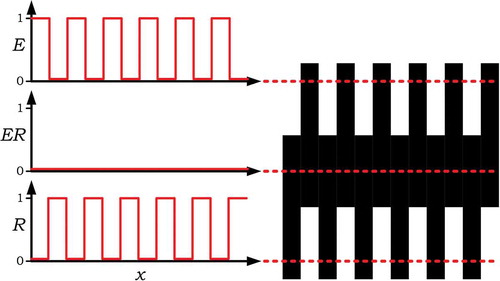
Fig. 13 The same situation as in Fig. 12, except that the reflectance pattern has a slightly increased spacing, so that toward the right portion of the pattern regions of non-zero illumination overlap with regions of non-zero reflectance, so that there is considerable reflected light.
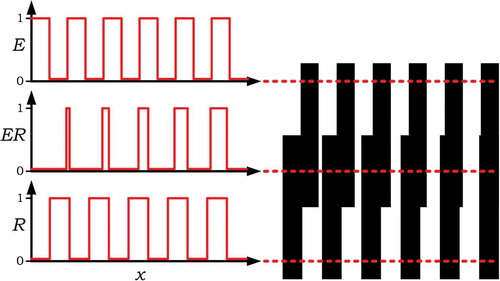
Fig. 14 The same situation as in Fig. 13, except that the illuminance and reflectance patterns are much finer. The same overall variation in reflected intensity is apparent.
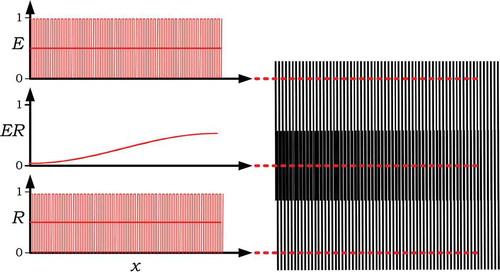
Fig. 15 In analogy to Fig. 13, this shows an illuminant spectral power distribution that varies with wavelength, illuminating a surface whose spectral reflectance function also varies with wavelength. In this case the product ER is the spectral power distribution of the reflected light, often called the color stimulus function. ER displays, effectively, a moiré pattern in the wavelength domain.
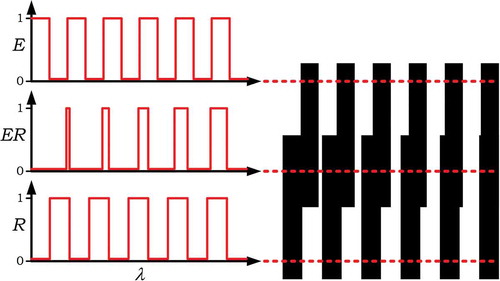
Fig. 19 The left box was illuminated with 100 CRI light (from two 60 W, 2750 K incandescent lamps) and the matching objects at right were illuminated with 80 CRI light (from two 13 W, 2750 K CFL lamps). They were photographed simultaneously in a single digital camera image. Compared to the left, at right the red pepper, strawberries, and tomatoes appeared less red, the wood looked slightly greenish, and the purple petunia and violet lobelia petals appeared blue. Other objects had smaller color shifts.
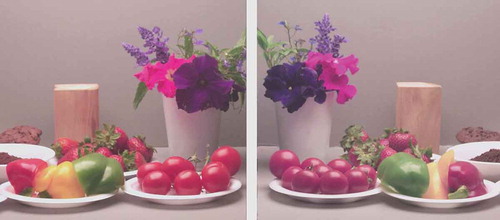
Fig. 20 Example of two fairly jagged SPDs that both have the same fairly high Ra value of 93. The SPD shown with a solid line is for a source with chromaticity of (0.3386, 0.3509) and CCT of 5250 K. The SPD shown with a dashed line is for a source with chromaticity of (0.3804, 0.3767) and CCT of 4000 K.
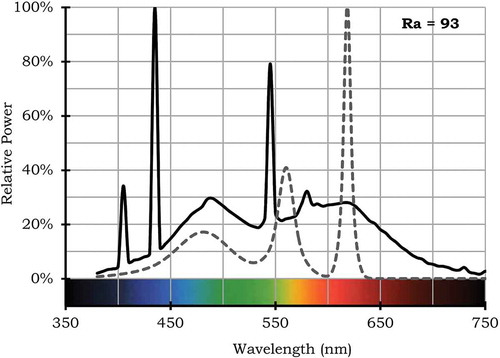
APPENDIX A: TERMS TABLE A.1 Definition of key concepts that support an understanding of color rendering


